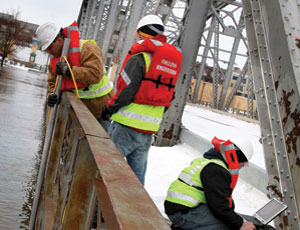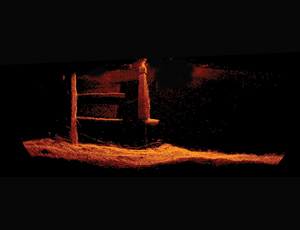State transportation officials are avoiding weeks or even months of wait time in inspecting underwater bridge components by using the latest in sonar imaging technology. The method’s potential will become the focus of a federal study next year.


This spring’s record floods posed high risks for the 80-year-old Sorlie Bridge, which connects Grand Forks, N.D., and East Grand Forks, Minn. Flowing 30 ft higher than normal, the fast-moving Red River of the North engulfed the 605-ft-long, two-span truss structure’s timber pilings and lapped at its lower beams, conditions that can lead to severe scouring.
Rather than wait for the river to recede to levels safe for human divers, the North Dakota and Minnesota transportation departments, which jointly maintain the Sorlie Bridge, used a free underwater sonar imaging technology demonstration to get results immediately. “No excessive undermining of the foundation was detected,” says Gary Doerr, head of NDDOT’s bridge management section. While the agencies still plan to conventionally inspect the bridge, “It will be good to have the scanning results as a backup,” he says.
Sonar scanning has been used for underwater inspections for nearly two decades, but the ability to produce high-resolution images under a broader range of water quality and flow conditions has only recently become feasible, says Terry Browne, division manager and director of underwater technologies for Collins Engineers Inc., Milwaukee.
“The combination of wide bandwidths and narrow pulse beams provides highly detailed images, accurate quantities and useful measurements of underwater surfaces, including scour depressions, debris accumulation and exposed pier footings,” says Browne, whose firm conducted the Sorlie Bridge demonstration. “These capabilities are particularly useful in waterways with poor water quality, low visibility and fast flowing velocity with dangerous currents, conditions usually hazardous for divers.”
Just what role underwater imaging can play in bridge inspections is the subject of a two-year Transportation Pooled Fund Study set to begin next year. Funded by six states and the Federal Highway Administration, the study will determine to what extent the technology can supplement and, perhaps, replace divers.
“Our goal is to provide a scientific assessment of the quality we can get from underwater imaging technologies and compare them to conventional methods, such as divers,” says Mike Johnson, chief officer of specialty investigations for the California Dept. of Transportation, the study’s lead agency. “We’ll look at its applicability for structural material and water conditions, as well as time, cost and personnel safety issues.”
One person already convinced of underwater scanning’s potential benefits is Mike Todsen, assistant bridge inspection program manager for the Iowa Dept. of Transportation. During the summer of 2008, the technology provided IDOT with fast answers about the 5,760-ft-long, U.S. 20 bridge over the Mississippi River in Dubuque, when three barges broke loose and struck several of the structure’s 71-ft tall piers during high flow conditions. One barge became lodged atop supporting riprap.
“The barge was hung up there for close to a month,” Todsen says. Underwater imaging revealed the piers and footings were undamaged, and the riprap could hold until river conditions allowed a crane to remove the barge.
“The technology can help identify features that require more detailed examinations by engineer-divers, enabling them to work more efficiently,” Browns says. “Typically, river water in many areas of our state has the consistency of chocolate milk, which requires divers to literally conduct bridge inspections by hand. And in flood conditions, high water can create a scour hole that silts back in as the river goes down. You may never know what the condition is.”




Post a comment to this article
Report Abusive Comment